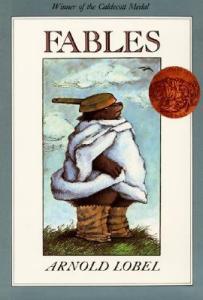An apple in time saves before you leap.

This is a strange book. It's not bad, but it kind of makes me wonder why he wrote this. I want to know the story behind this book.
It's a little wordy to read to a young child. As the title suggests, it's a series of short fables, each less than one page long and illustrated by a full-page image on the facing page. Some of them are reasonable and similar to popular parables, but some of them are rather unusual. Most of them are very reminiscent of Aesop's fables, where the characters act abnormally in order to prove a point in the story, or things don't actually follow the laws of physics. In one story, a hippopotamus eats too much and getting stuck in a table. In another story, a young kangaroo troublemaker gets a visit at home from the principal and the whole family throws spitballs at each other for fun.
Sometimes the moral seems kind of shoehorned into it like a story about a dog who finds a ring, mistakenly believes it to be magic and wishes on it, and ends up getting a reward because it was lost: "Wishes, on their way to coming true, will not be rushed." That story didn't really need a moral, but it wouldn't fit in the book otherwise. Or the cat who is fishing and then gets sad because he doesn't think he's going to catch anything, then catches something and gets happy again: "All's well that ends with a good meal." That's just strange.
A lot of these are really weird. They're all animal based, which is pretty common (the Aesop's fable about the fox and the grapes is where we get the phrase "sour grapes" from). They're basically modernized versions of Aesop's fables. The crocodiles are living in a house with wallpaper that is integral to the story. There's a baboon with an umbrella. Since the traditional Aesop's fables take place in ancient Greece, these are an interesting update to the formula. It's nontraditional to have camels wanting to be ballerinas.
I'm not sure I'm getting what the author intended from these stories, but they're really fascinating as a study on fable. It's got a lot of interesting characters and language, and words to learn, and compelling stories. This is probably for kids who are on the verge of reading to themselves, if not older.